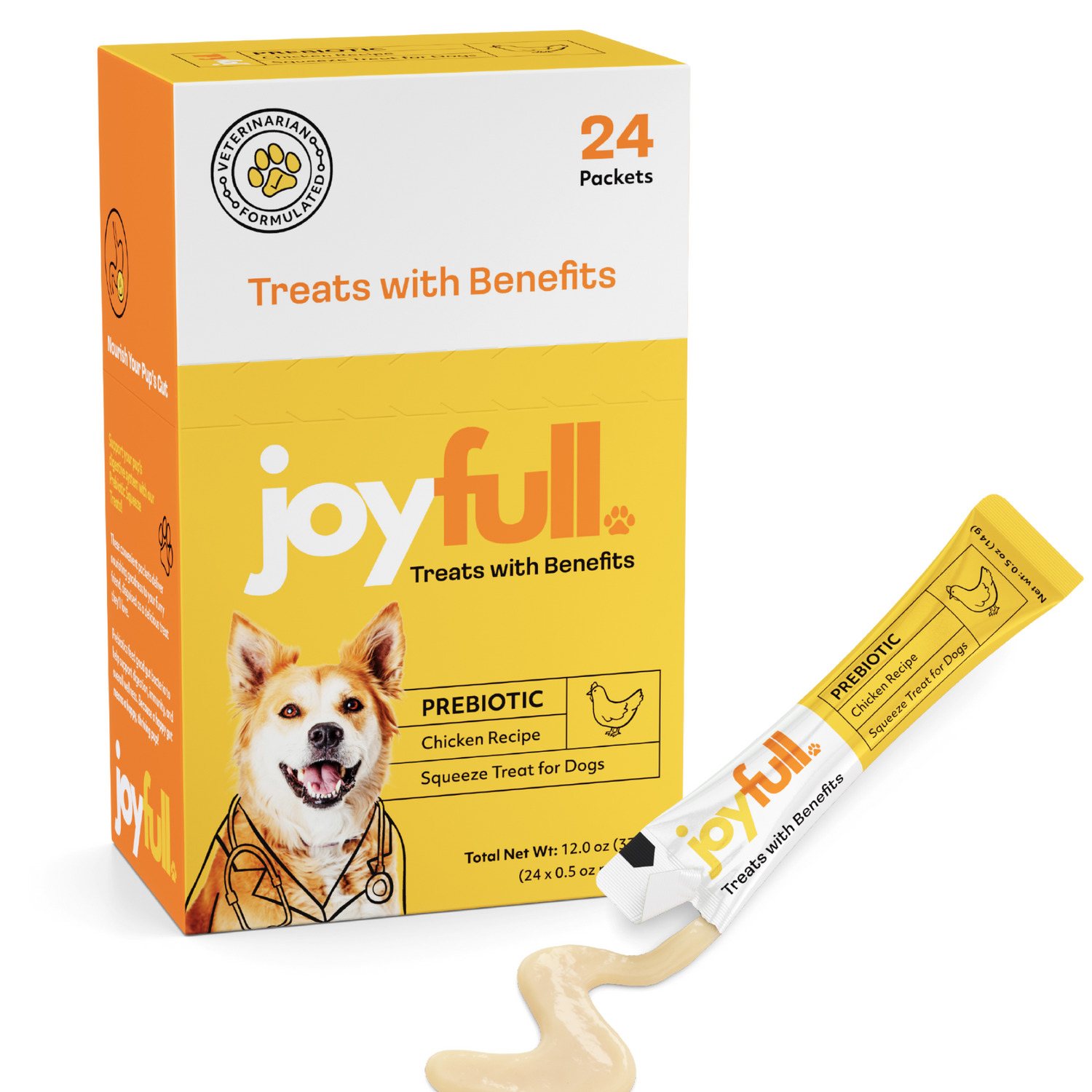
Top 8 Best Ingredients for Dog Treats in 2025
As pet parents, we've all stood in the treat aisle, overwhelmed by choices and confusing ingredient lists. The desire to give our dogs the very best is universal, but navigating the world of pet nutrition can feel like a full-time job. What if the secret to healthier, happier treating isn't in a complex formula, but in simple, powerful ingredients you can recognize?
This guide is for the discerning pet owner who believes that wellness starts with what's in the bowl or the treat jar. We're moving beyond generic fillers and diving into the best ingredients for dog treats that offer real, tangible nutritional benefits. From supporting healthy digestion with pumpkin to providing powerful antioxidants with blueberries, these whole-food powerhouses can transform treat time into a truly healthful experience.
Inside, you will find a detailed breakdown of eight essential ingredients, complete with their specific health advantages, sourcing advice, and practical ways to incorporate them into your dog's diet. Whether you are a dedicated DIY enthusiast looking for new recipes or a careful label-reader committed to buying the highest quality commercial products, this information will empower you to make smarter choices that contribute directly to your dog's vibrant, joyful life.
1. Peanut Butter (Xylitol-Free)
A classic favorite for a reason, natural peanut butter is one of the best ingredients for dog treats, celebrated for its irresistible flavor and impressive nutritional profile. It serves as a fantastic source of protein for muscle maintenance, healthy monounsaturated fats for heart health, and essential vitamins like niacin (B3) and vitamin E. Its creamy texture also makes it an excellent binder for homemade baked goods, holding other ingredients together perfectly.
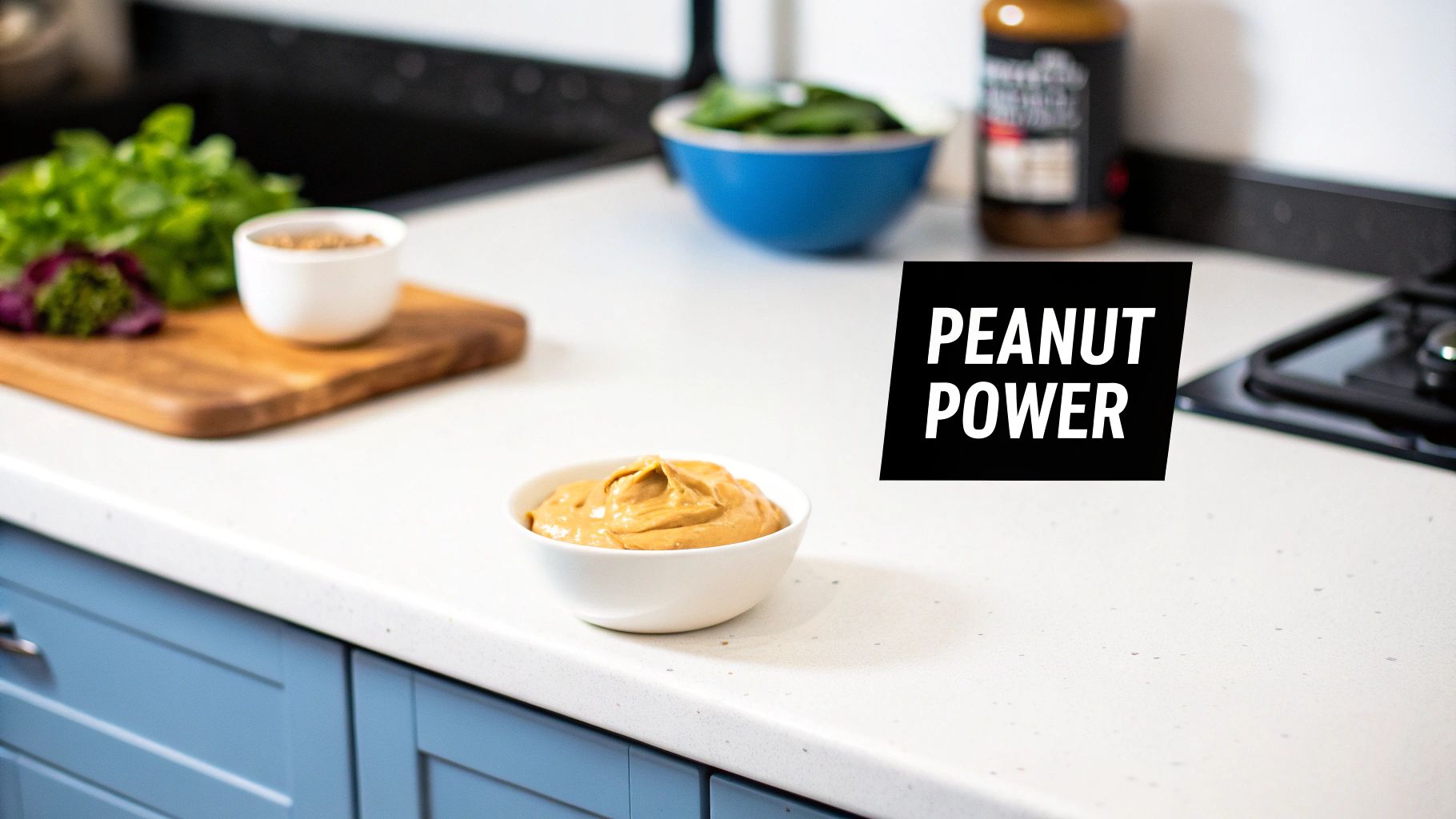
The most critical factor when choosing peanut butter is to ensure it is 100% free of xylitol, an artificial sweetener that is extremely toxic to dogs, even in small amounts. Always read the ingredient label carefully.
How to Use Peanut Butter in Dog Treats
Peanut butter's versatility makes it a go-to ingredient for various treat types, from simple stuffers to celebratory "pupcakes." Its rich, nutty aroma is highly motivating for training and a comforting flavor for everyday rewards.
- No-Bake Treats: Mix with plain yogurt or pumpkin puree and freeze in ice cube trays for a cooling summer snack.
- Enrichment Toys: It is the classic filling for Kong toys, often layered with kibble or other healthy ingredients to create a long-lasting puzzle.
- Baked Biscuits: Combine with whole wheat flour and oats to create crunchy, shelf-stable biscuits.
- Pill Concealer: A small dollop can effectively hide medication, making pill time less stressful for you and your dog.
Key Insight: Choose natural peanut butter where the only ingredient is "peanuts." Avoid added sugar, salt, and hydrogenated oils to maximize health benefits and minimize unnecessary additives.
Actionable Tips for Safe Use
To incorporate this ingredient safely, moderation is key. Peanut butter is calorie-dense, and treats should never account for more than 10% of your dog's daily caloric intake. Before introducing it, offer a tiny amount to check for any potential allergic reactions. To reduce its caloric density, try mixing it with pureed sweet potato, banana, or pumpkin.
2. Pumpkin Puree
Pure pumpkin puree is a nutritional powerhouse and one of the best ingredients for dog treats, widely recommended by veterinarians for its digestive benefits. It is packed with soluble fiber, which helps regulate the digestive system, making it effective for both diarrhea and constipation. Beyond fiber, pumpkin offers an abundance of beta-carotene (a precursor to vitamin A), potassium, and vitamin C, all while being naturally low in calories.
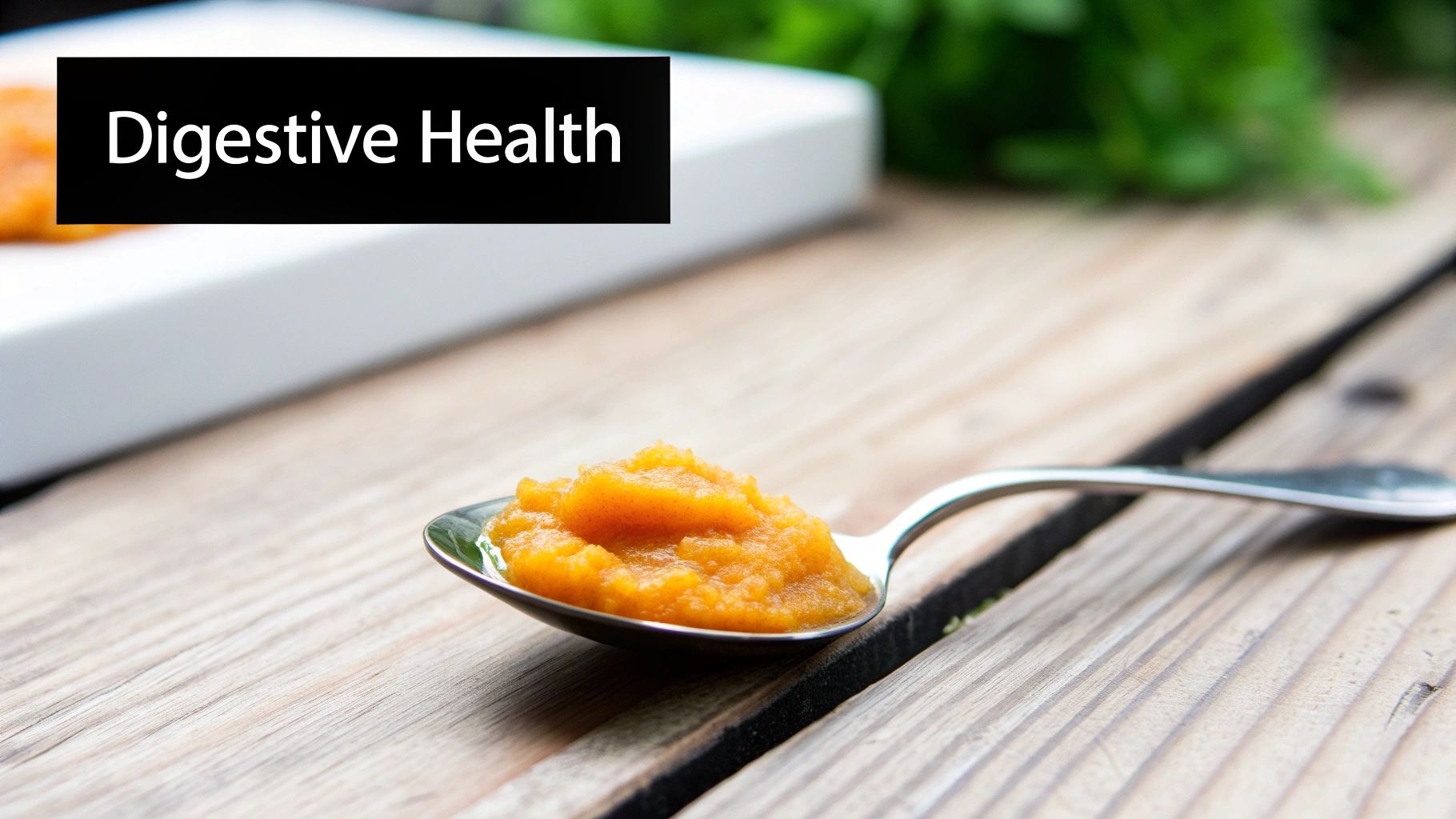
It is crucial to use 100% pure pumpkin puree and never pumpkin pie filling, which contains added sugars, spices like nutmeg, and other ingredients that can be harmful to dogs. Always check the label to ensure "pumpkin" is the only ingredient.
How to Use Pumpkin Puree in Dog Treats
Pumpkin’s moist, earthy-sweet profile makes it a versatile addition to many treat recipes, particularly for dogs with sensitive stomachs or those on a weight management plan. Its moisture content helps bind ingredients and creates a softer treat texture.
- Baked Goods: Combine with oat flour and a touch of cinnamon to create soft, chewy cookies that are gentle on the stomach.
- Frozen Snacks: Mix with plain yogurt or banana and freeze in molds for a refreshing "pupsicle" on a hot day. For even more inspiration, explore these healthy dog treat recipes that often feature pumpkin.
- Dehydrated Chews: Spread a thin layer of puree on a silicone mat and dehydrate to create simple, low-calorie fruit-leather-style chips.
- Meal Topper: A simple spoonful mixed into your dog's regular food can boost fiber and nutrient intake.
Key Insight: Pumpkin is an exceptional low-calorie filler. You can replace some of the higher-calorie ingredients like flour or fats in a recipe with pumpkin puree to reduce the overall calorie count without sacrificing volume.
Actionable Tips for Safe Use
To introduce pumpkin safely, start with small amounts: about one teaspoon for small dogs and up to a few tablespoons for larger breeds. Its high fiber content can cause digestive upset if too much is given at once. To avoid waste, freeze any leftover canned pumpkin in ice cube trays for perfectly portioned amounts you can use later in treats or as a meal additive.
3. Sweet Potato
A vibrant and naturally sweet root vegetable, sweet potato stands out as one of the best ingredients for dog treats due to its exceptional nutritional density and digestive benefits. It is a powerhouse of complex carbohydrates for sustained energy, dietary fiber for a healthy gut, and essential vitamins. Sweet potatoes are particularly rich in beta-carotene, which the body converts to vitamin A for vision and immune support, as well as vitamin C and manganese.
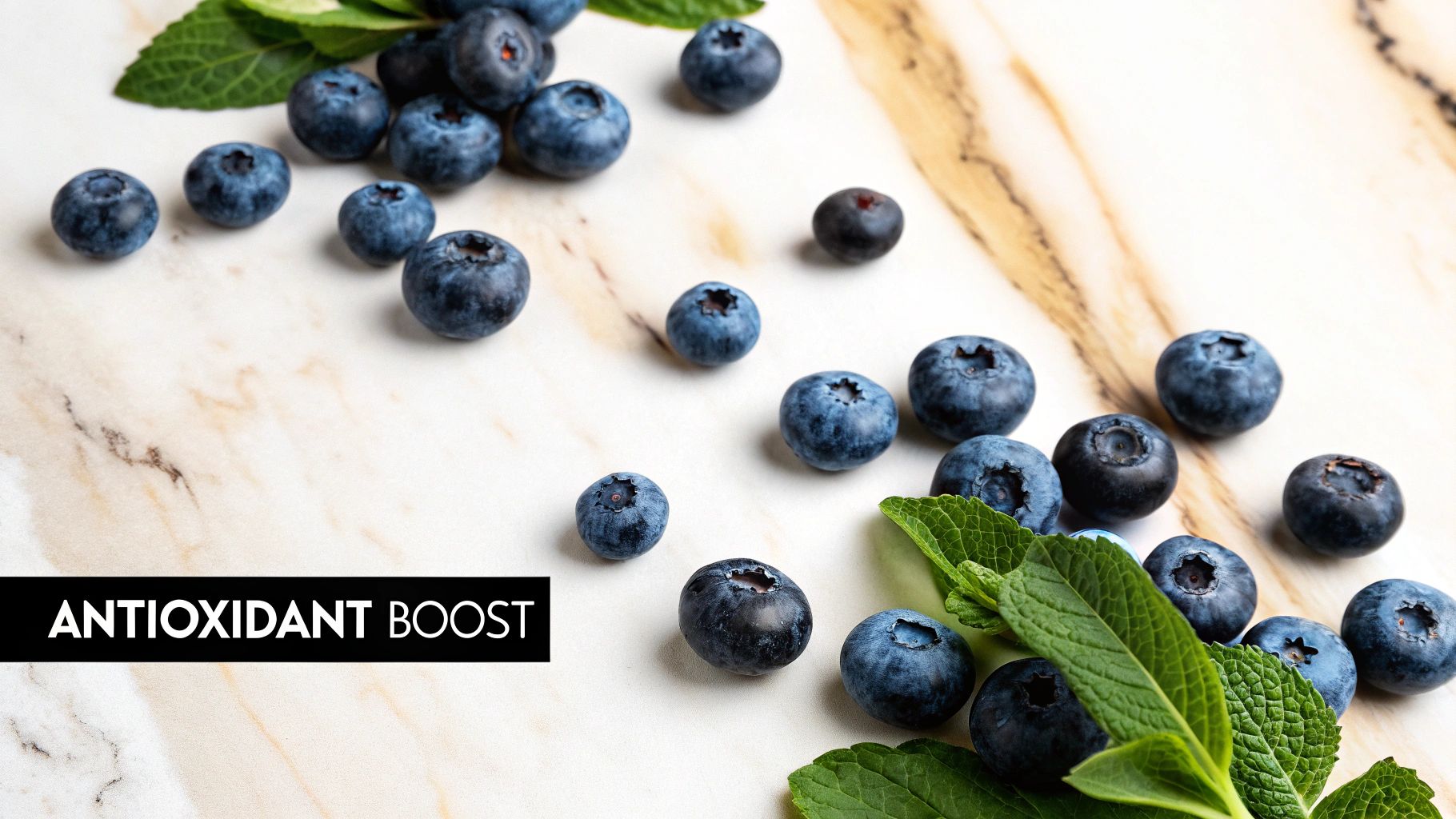
This versatile ingredient is naturally grain-free, making it an ideal carbohydrate source for dogs with sensitivities or allergies to grains like wheat or corn. Its inherent sweetness and moisture enhance the flavor and texture of homemade treats without any need for artificial additives.
How to Use Sweet Potato in Dog Treats
Sweet potato's firm texture when cooked makes it suitable for a wide array of treat preparations, from chewy jerky-like snacks to soft-baked biscuits. Its appealing flavor makes it a favorite among even the pickiest of canine palates.
- Dehydrated Chews: Thinly slice and dehydrate for a simple, chewy, and long-lasting single-ingredient snack that helps clean teeth.
- Training Treats: Dice into small cubes, bake at a low temperature until firm, and use as a healthy, low-calorie reward for training sessions.
- Baked Biscuits: Use pureed sweet potato as a binder and natural sweetener in recipes with oat flour and a protein source like chicken or turkey.
- Frozen Delights: Mix pureed sweet potato with plain yogurt and freeze in molds for a refreshing and nutrient-packed treat on hot days.
Key Insight: Always cook sweet potatoes before serving them to your dog. Raw sweet potato can be difficult to digest and may cause an upset stomach or even intestinal blockage. Baking, boiling, or steaming makes the nutrients more available and ensures safety.
Actionable Tips for Safe Use
To incorporate sweet potato safely, ensure it is properly prepared and offered in moderation as part of a balanced diet. Start with a small amount to make sure it agrees with your dog's digestive system. Remove the skin before preparing, as it can be tough for some dogs to digest. For a balanced treat, combine pureed sweet potato with lean proteins or other dog-safe vegetables.
4. Oats (Rolled or Oat Flour)
Oats are a wholesome and easily digestible grain, making them one of the best ingredients for dog treats, especially for pets with sensitivities to wheat. They provide a fantastic source of complex carbohydrates for sustained energy and soluble fiber, which aids in regulating digestion. Oats are also packed with B vitamins for energy metabolism and beta-glucans, a type of fiber known to support both digestive and heart health. Their mild flavor and excellent binding properties make them a structural powerhouse in many treat recipes.
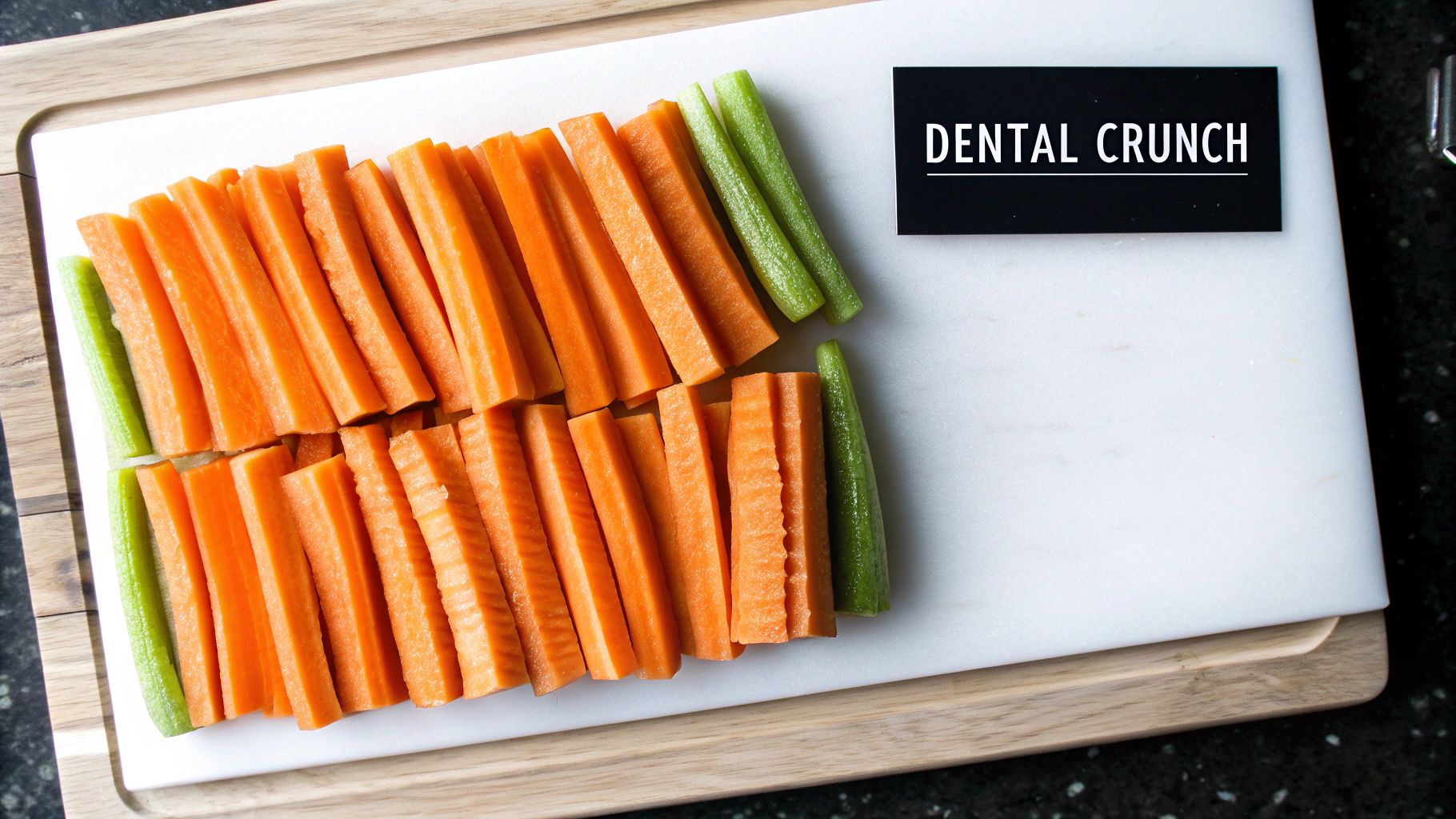
It is essential to use plain, unsweetened oats, such as rolled or quick oats. Never use instant oatmeal packets, as they often contain added sugar, artificial flavors, and even xylitol, which is extremely toxic to dogs.
How to Use Oats in Dog Treats
The versatility of oats allows them to be used whole for texture or ground into a fine flour as a base for baked goods. Their gentle nature makes them an ideal carbohydrate source that pairs well with fruits, vegetables, and proteins, adding substance and nutritional value to any treat.
- Baked Biscuits: Combine oat flour with pumpkin puree and a touch of cinnamon for classic, crunchy biscuits.
- No-Bake Energy Balls: Mix rolled oats with peanut butter and mashed banana, then roll into bite-sized balls and chill.
- Training Treats: Create small, soft-baked training treats by mixing oat flour with a protein source like shredded chicken or salmon.
- Wheat Flour Substitute: Grind rolled oats in a food processor or blender to create a nutritious, gluten-friendly flour for nearly any dog treat recipe.
Key Insight: While oats are naturally gluten-free, they are often processed in facilities that handle wheat. If your dog has a severe gluten allergy, choose certified gluten-free oats to avoid cross-contamination.
Actionable Tips for Safe Use
To maximize digestibility and safety, cook oats before serving them plain to your dog. When used in baked treats, the baking process handles this for you. As with any new food, introduce oats gradually to monitor for any digestive upset. Store homemade oat flour in an airtight container in a cool, dark place to prevent it from going rancid. Combining oats with a protein source like eggs or lean meat helps create a more nutritionally balanced snack.
5. Chicken (Fresh or Dehydrated)
A cornerstone of canine nutrition, chicken is a lean, high-quality protein that ranks among the best ingredients for dog treats. It is highly digestible and palatable for most dogs, providing the essential amino acids necessary for muscle development, tissue repair, and overall systemic health. Chicken is also a natural source of important nutrients like vitamins B3 and B6, phosphorus, and selenium, which support energy metabolism and antioxidant function.
Whether it's fresh, cooked, or dehydrated, chicken's strong aroma and rich flavor make it a powerful motivator, perfect for training sessions and high-value rewards. Its versatility allows it to be prepared in countless ways to suit any dog's preference.
How to Use Chicken in Dog Treats
Chicken can be the star ingredient in a wide range of homemade treats, from simple boiled bites to crunchy, long-lasting jerky. Its universally loved taste makes it a reliable choice for picky eaters and a fantastic base for combining with other healthy ingredients.
- Training Treats: Simply boil or bake boneless, skinless chicken breast and dice it into small, pea-sized cubes for a low-fat, high-value reward.
- Dehydrated Jerky: Slice chicken breast into thin, uniform strips and dehydrate them in an oven or dehydrator for a chewy, protein-packed snack.
- Baked Biscuits: Combine cooked, shredded chicken with oat flour and pureed vegetables like sweet potato to create flavorful, crunchy biscuits.
- Frozen Pupsicles: Blend cooked chicken with a bit of bone broth or water and freeze in molds for a refreshing and hydrating summer treat. These can be particularly soothing for dogs with joint discomfort; you can learn more about how certain treats support joint health by exploring our guide on dog treats for arthritis.
Key Insight: Always use boneless, skinless chicken to keep the fat content low. Avoid adding any seasonings like salt, onion, or garlic, as they can be harmful to dogs. Pure, unadulterated chicken is the healthiest option.
Actionable Tips for Safe Use
Proper preparation is crucial to ensure chicken is safe for your dog. Always cook chicken to an internal temperature of 165°F (74°C) to eliminate harmful bacteria like Salmonella. Never feed your dog cooked chicken bones, as they can splinter and cause serious internal injury. For homemade jerky, dehydrate thin strips at 160-180°F for 3 to 6 hours until brittle. Store homemade chicken treats in an airtight container in the refrigerator or freezer to maintain freshness and prevent spoilage.
6. Blueberries
Often celebrated as a superfood for humans and dogs alike, blueberries are nutritional powerhouses that make for excellent ingredients in dog treats. These small berries are packed with antioxidants, fiber, and essential vitamins C and K. They are particularly rich in anthocyanins, the compounds responsible for their deep blue color, which offer potent anti-inflammatory benefits and support overall cellular health. Their low-calorie and naturally sweet profile adds flavor and moisture without unnecessary sugars.
Blueberries are a fantastic functional ingredient, known to support cognitive function, urinary tract health, and the immune system. Their small, manageable size makes them an ideal addition to a wide range of treat recipes.
How to Use Blueberries in Dog Treats
Blueberries' versatility allows them to be used fresh, frozen, or even dehydrated, making them one of the most convenient and best ingredients for dog treats year-round. Their natural sweetness enhances the palatability of treats, making them highly appealing to dogs.
- Frozen Treats: Blend with plain yogurt or kefir and freeze in molds for a refreshing and antioxidant-rich summer snack.
- Baked Goods: Fold whole or mashed blueberries into oat cookie or pupcake batter for a burst of flavor and moisture.
- Training Rewards: Use fresh or frozen individual blueberries as low-calorie, high-value rewards during training sessions.
- Food Toppers: Sprinkle a few fresh blueberries over your dog's regular meal for an easy nutritional boost.
Key Insight: Both fresh and frozen blueberries offer similar nutritional value, so feel free to use whichever is more convenient. Frozen berries are often more affordable and can be stored for longer periods, ensuring you always have a healthy treat ingredient on hand.
Actionable Tips for Safe Use
While blueberries are safe, they should be given in moderation as part of a balanced diet. To ensure they are a safe and enjoyable addition, start by offering just a few to see how your dog's system responds. To prevent choking, especially in small breeds or puppies, mash or puree the berries before mixing them into treat dough or serving them. Buying organic is a great way to minimize your dog’s exposure to pesticide residue.
7. Carrots
A wonderfully crunchy and naturally sweet vegetable, carrots are one of the best ingredients for dog treats, offering a low-calorie option packed with significant health benefits. They are an exceptional source of beta-carotene, which the body converts into vitamin A, crucial for vision, immune function, and skin health. Carrots also provide dietary fiber for digestive regularity and antioxidants that help fight free radicals.
Their satisfying crunch not only makes them a favorite snack but also provides a natural way to help clean teeth and massage gums, promoting better dental hygiene. The versatility of carrots allows them to be used raw, cooked, grated, or pureed, making them an easy addition to any treat recipe.
How to Use Carrots in Dog Treats
Carrots can be incorporated into a wide variety of treats, from simple, refreshing snacks to complex baked goods. Their natural sweetness enhances flavor without adding sugar, and their vibrant color makes treats visually appealing.
- Frozen Teething Chews: Offer whole, frozen carrots to teething puppies for a safe and soothing chew that helps relieve gum discomfort.
- Dehydrated Chips: Slice carrots thinly and dehydrate them to create crispy, shelf-stable chips that serve as excellent low-calorie rewards.
- Baked Goods: Add grated or pureed carrots to biscuit or "pupcake" batter for extra moisture, fiber, and nutrients.
- Nutrient Boosters: Mix finely grated raw carrots into homemade meatball treats or your dog's regular food for a simple nutritional enhancement.
Key Insight: To maximize nutrient absorption, lightly steam or puree carrots before adding them to treats. This process helps break down the tough cellular walls, making the beta-carotene more bioavailable for your dog.
Actionable Tips for Safe Use
While carrots are a healthy choice, it is important to prepare them properly to ensure safety and digestibility. Always cut them into appropriate, bite-sized pieces to prevent choking, especially for smaller dogs or enthusiastic eaters. For a more detailed guide on healthy snacks like carrots, you can learn more about the best healthy treats for your dog. When possible, opt for organic carrots to minimize your dog’s exposure to pesticides.
8. Plain Greek Yogurt (Unsweetened)
Plain, unsweetened Greek yogurt is a creamy, probiotic-rich powerhouse that stands out as one of the best ingredients for dog treats. Celebrated for its gut-health benefits, it is an excellent source of calcium for strong bones, protein for lean muscle, and live active cultures that support a healthy digestive system. Its tangy flavor and smooth texture make it a versatile addition to both frozen and baked recipes.
The key is to select a product that is plain and completely free of added sugars or artificial sweeteners like xylitol, which is highly toxic to dogs. The straining process used to make Greek yogurt removes much of the lactose, making it easier for many dogs to digest compared to regular yogurt.
How to Use Plain Greek Yogurt in Dog Treats
Greek yogurt's cool, creamy consistency makes it perfect for a wide array of treats, from simple frozen snacks to healthy "frostings." Its probiotic content can be particularly beneficial for dogs with sensitive stomachs, helping to maintain a balanced gut microbiome.
- Frozen "Pupsicles": Blend with dog-safe fruits like blueberries or bananas and freeze in ice cube trays for a refreshing and healthy summer treat.
- Enrichment Topper: A dollop on top of your dog's regular kibble can add moisture, flavor, and valuable probiotics to their daily meal.
- Healthy Frosting: Use it as a base for a simple, healthy frosting for homemade dog birthday cakes or pupcakes.
- Digestive Aid: Mix with pumpkin puree to create a soothing and effective snack for dogs experiencing minor digestive upset.
Key Insight: Look for Greek yogurt with the "Live & Active Cultures" seal on the label to ensure you're providing the maximum probiotic benefit. Plain, non-fat, or low-fat options are the best choice.
Actionable Tips for Safe Use
While many dogs tolerate dairy well, it's best to introduce yogurt slowly. Start with a very small spoonful to see how your dog's system reacts before incorporating it regularly into their treats. As with all treats, moderation is essential to prevent weight gain and maintain a balanced diet. Yogurt should complement, not replace, their primary food source.
Top 8 Dog Treat Ingredients Comparison
| Ingredient | Implementation Complexity 🔄 | Resource Requirements ⚡ | Expected Outcomes 📊 | Ideal Use Cases 💡 | Key Advantages ⭐ |
|---|---|---|---|---|---|
| Peanut Butter (Xylitol-Free) | Low - easy to mix or coat | Low - affordable, readily available | High palatability, protein & healthy fats boost | Binding, flavoring, pill administration | Very tasty, versatile, supports skin & coat |
| Pumpkin Puree | Low - simple to add or blend | Low - fresh or canned available | Digestive aid, low calorie, immune support | Digestive issues, weight management | High fiber, gut health, natural moisture |
| Sweet Potato | Medium - requires cooking/dehydration | Moderate - cooking or dehydrating needed | Sustained energy, digestive support, anti-inflammatory | Grain-free diets, training treats | Nutrient-dense, antioxidant rich, grain-free |
| Oats (Rolled or Oat Flour) | Medium - may require grinding or cooking | Low - cost-effective and accessible | Digestive health, energy, cholesterol regulation | Baking, binding, gentle on digestion | Versatile, fiber-rich, supports heart & digestion |
| Chicken (Fresh or Dehydrated) | Medium-High - requires cooking, dehydrating | Moderate-High - needs fresh protein source | Muscle building, high palatability, immune support | Training treats, protein boost | Complete protein, highly palatable, lean |
| Blueberries | Low - easy to add fresh or frozen | Moderate - more costly than other fruits | Cognitive support, antioxidant, urinary health | Cognitive health, antioxidant-rich treats | High antioxidant power, supports immunity |
| Carrots | Low - can be raw, cooked, grated | Low - inexpensive and widely available | Dental health, eye support, low calorie | Dental chews, low-calorie treats | Crunchy, beta-carotene rich, supports vision |
| Plain Greek Yogurt (Unsweetened) | Low-Medium - no cooking, needs refrigeration | Moderate - requires refrigeration | Digestive health, probiotic benefit, immune support | Gut health, frozen treats | Probiotic-rich, high protein, supports digestion |
Treating with Purpose: Your Next Steps to a Healthier Pet
Navigating the world of canine nutrition can feel complex, but as we've explored, the foundation of a healthy diet is refreshingly simple. Choosing the best ingredients for dog treats isn't about finding exotic or expensive superfoods; it's about returning to whole, recognizable, and nutrient-dense options. The journey through ingredients like xylitol-free peanut butter, pure pumpkin puree, sweet potatoes, and rolled oats reveals a clear pattern: wholesome foods for humans often translate into powerful, functional snacks for our dogs.
By incorporating these powerhouse ingredients, you elevate treat time from a simple reward to a proactive contribution to your dog's health. The lean protein from fresh chicken helps build strong muscles, the antioxidants in blueberries support cellular health, and the fiber in carrots aids digestion. This knowledge empowers you to become a more discerning consumer and an even better pet parent, whether you are browsing the treat aisle or preheating your oven to bake a homemade batch.
Key Takeaways for Conscious Treat-Giving
To put this knowledge into practice, focus on these core principles:
- Read Every Label: When buying commercial treats, scrutinize the ingredient list. The first few ingredients should be recognizable whole foods, not fillers like corn, wheat, or soy, or ambiguous terms like "meat by-products."
- Embrace Whole Foods: The most reliable path to healthy treating is using single-ingredient or limited-ingredient foods. Dehydrated sweet potato, a spoonful of plain Greek yogurt, or a few fresh blueberries are excellent, minimal-effort rewards.
- Mind the 10% Rule: No matter how healthy the ingredients, treats should never replace a balanced meal. Always ensure that treats constitute no more than 10% of your dog's total daily caloric intake to prevent weight gain and nutritional imbalances.
Creating a Holistically Healthy Environment
Your commitment to your pet's well-being extends beyond their food bowl. A healthy dog is one that thrives in a safe, nurturing environment. Just as selecting the right ingredients for treats is vital for your dog's internal health, ensuring a safe home environment, including the use of pet-friendly cleaning products like specific pet-safe wood floor cleaners, is another key step in fostering your pet's overall well-being. This comprehensive approach, which considers both diet and environment, is the hallmark of a truly dedicated pet owner.
Ultimately, the power to enhance your dog’s vitality is in your hands. By choosing treats made from the best ingredients, you are making a long-term investment in their health, happiness, and longevity. It's a simple, daily act of love that delivers profound benefits, one delicious, purposeful bite at a time.
Ready to treat your dog to the best without the prep work? At Joyfull, we transform these very same principles into scientifically-reviewed, better-for-you snacks. Explore our range of treats made with clean, functional ingredients and give your pet the purposeful nutrition they deserve.
